The number of asylum applications in Germany increased by 51.1% to reach 351,915 in the previous year.Migration has emerged as a significant political challenge, with communities struggling to accommodate the influx of newcomers.Temporary border controls were implemented at frontiers with Poland, the Czech Republic and Switzerland.The number of people applying for asylum in Germany last year rose to 351,915, an increase of 51.1% compared with the year before.The largest number of asylum-seekers came from Syria, with 104,561 applications, followed by Turkish citizens with 62,624 asylum pleas and 53,582 Afghans, Germany’s Federal Office for Migration and Refugees said Monday.Migration has become a huge political problem for the government and a hot-button topic in Germany as local communities are struggling to house the many newcomers.7 DEAD, 16 INJURED IN GERMANY AFTER SUSPECTED MIGRANT-SMUGGLING VEHICLE CRASHESGerman Chancellor Olaf Scholz, who faces enormous pressure from the opposition and elsewhere to halt the trend, has said that “too many are coming.” Dozens of people from all over the world line in front of the central registration center for asylum seekers in Berlin, Germany, on Sept. 25, 2023. The number of people applying for asylum in Germany last year rose to 351,915, an increase of 51.1% compared with the year before. (AP Photo/Markus Schreiber, File)Late last year, Scholz and the 16 state governors agreed on new and stricter measures to curb the high number of migrants flowing into the country, reaching a compromise that included speeding up asylum procedures, benefit restrictions for asylum-seekers and more financial aid from the federal government for the states and local communities dealing with the influx.Germany has also taken in more than 1 million Ukrainians since the start of Russia’s war in their homeland.GERMAN POLICE ARREST 2 MEN ACCUSED OF SMUGGLING OVER 200 MIGRANTS INTO EUROPEIn the fall, Germany introduced temporary border controls at its frontiers with Poland, the Czech Republic and Switzerland, going a step beyond a move last month to strengthen checks on its eastern border. The Central European country has been conducting similar systematic checks at its border with Austria since 2015.In a further measure to curb the number of migrants in the country, the government has also been trying to facilitate deportations of unsuccessful asylum-seekers and stiffen the punishment of people smuggling migrants.Last year’s numbers are still far below the figures from 2015-16, when more than 1 million migrants came to Germany, mostly from Syria, Afghanistan and Iraq.
Breaking News
2024-10-27 A man who abused up to 3,500 girls online has been sentenced for crimes including manslaughter
2024-10-27 Rear Admiral Claims Government COVERED UP Alien Contact. We’ve Talked with ALIENS????
2024-10-27 BREAKING: UN Sec Council Passes Gaza Aid, US Sits Out; Trump Audio EXPOSES Pressure On MI Officials
2024-10-27 Missing Juvenile Aamina Turner from the 12th District – Blotter
2024-10-27 Missing Endangered Person Ivelisse Lugo from the 2nd District – Blotter
Static News
500k views later The FLORIDA...
phillynews215 2021-04-27 50 Comments on Body Cam: Officer Fatal Shooting Man with a Sword – Pomona Police March 30- 2020
#officerinvolvedshooting #policeshooting #Pomona Policedepartment Please...
phillynews215 2021-04-27 50 Comments on Bodycam Shows Deputies Shooting Armed Suspect in Greenville, South Carolina
** (Disclaimer: This video content...
Video brought to you by...
Rafael Nieves 2024-10-27 0 Comment on A man who abused up to 3,500 girls online has been sentenced for crimes including manslaughter
A "relentless and cruel" online...
Rafael Nieves 2024-10-27 38 Comments on Rear Admiral Claims Government COVERED UP Alien Contact. We’ve Talked with ALIENS????
Robby Soave and Briahna Joy...
Rafael Nieves 2024-10-27 0 Comment on BREAKING: UN Sec Council Passes Gaza Aid, US Sits Out; Trump Audio EXPOSES Pressure On MI Officials
The Hill’s Kevin Cirilli recaps...
Rafael Nieves 2024-10-27 0 Comment on Missing Juvenile Aamina Turner from the 12th District – Blotter
The Philadelphia Police Department is...
Rafael Nieves 2024-10-27 0 Comment on Missing Endangered Person Ivelisse Lugo from the 2nd District – Blotter
The Philadelphia Police Department is...
phillynews215 2024-04-14 27 Comments on Supreme Court Ruling: Trump reacts to decision, discusses Israel-Hamas war | LiveNOW from FOX
The U.S. Supreme Court sided...
Subscribe NOW to The Breakfast...
phillynews215 2024-03-12 Comments Off on Brazilian police free 17 hostages from bus overtaken by gunman
Brazilian police said Tuesday they...
#CrimeCamNow On May 29, 2022,...
No International trip to race...
Proudly powered by ANGELHOUSE 2009 - 2024 | ALL YOUTUBE VIDEOS IS A REGISTERED TRADEMARK OF GOOGLE INC. | THE YOUTUBE CHANNELS AND BLOG FEEDS IS MANAGED BY THE RIGHTFUL OWNERS/CREATORS HOSTING BY PHILLYFINESTSERVERSTATS INC. ALL RIGHTS RESERVED




















